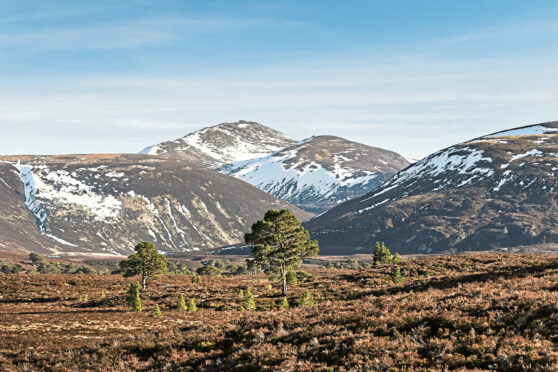
Descending the mountain Bynack More at the north-eastern edge of the vast Cairngorms, I surveyed the beautiful landscape.
The multiple tall peaks all around me contrasted dramatically with an ever-changing sky of moving clouds, patches of blue and low sun. It was 2.30pm, but the winter sunset would be coming in around two hours.
I stopped, sat on a large rock for a bite to eat and the last of my flask of tea, and mulled over my next objective. I checked a weather forecast app on my smartphone and worried about the potential for rain the next day. It seemed the wind, already buffeting strength at higher altitude, was set to increase at lower levels, too.
I looked at my map, assessing the route of the neighbouring mountain, Meall a’ Bhuachaille, and I did a few calculations.
This is what makes adventuring in the Scottish mountains in winter exciting and challenging. My plan for the two-day trip was to summit both the Munro, Bynack More, and the Corbett, Meall a’ Bhuachaille. I would also camp somewhere near or in the bothy on Ryvoan pass, between the two summits.
Temporarily without a vehicle, I was relying on public transport to the nearby town of Aviemore and maybe a lift from friends.
I was also prepared to scrap, or reassess, any of the above if the mountain conditions changed suddenly – and dangerously.
However, one of the best parts of the outing was being able to leave my large overnight rucksack hidden on the lower pass. I had all I needed for winter mountain walking in a smaller rucksack – and I would reclaim my overnight pack when the time came to camp.
The day had started well. Friends Jane and Denise, from Glasgow, were planning a walk on Bynack More so I would be assured of a lift to the start in Glenmore, 11km (seven miles) east of Aviemore Railway Station. This also meant I would enjoy some company on the first mountain. The walk started with a wide track that meanders through Glenmore Forest Park in Strath Nethy amid many fine trees, including majestic Scots pines.
A highlight is the curious green loch, An Lochan Uaine. It’s said the green appearance is most likely caused by reflected light from the trees that line it, although legend has it the colour is caused by pixies washing their clothes in it.
A fork in the track further on is signposted for Braemar, while straight on takes you to Ryvoan Pass, with the potential to walk through Abernethy Forest to Nethy Bridge. A well-constructed path leads up on to Bynack More. Apart from the final push on the mountain’s steeper northern side, the gradients are fairly gentle.
Our ascent was made far more strenuous and chilling due to a strong head and side-wind. From around 609 metres (2,000ft), visibility became limited, too.
The obvious path meant it was easy to stay on track although, because we couldn’t see far ahead, the many false summits served to repeatedly fool us.
On a fine day, it is worth continuing south from the summit cairn to the Barns of Bynack. Instead, Jane, Denise and I chose to make a direct return north, following the same route until we were finally below the clouds. It was a relief to have tailwind.
Which brought me to my rock and the contemplation of my plan. It would have been simple to descend, retrieve my overnight pack, set up camp and save the Corbett for the following day.
Yet, the weather forecast niggled at me and, as I left my friends. My camp could wait for later – I would complete a late-afternoon ascent of Meall a’ Bhuachaille.
The eastern path zig-zags steeply from close to Ryvoan Bothy to a high of 810m (2,657ft) – and it was a great advantage to start at an altitude of 396m (1,300ft).
I could feel my leg muscles groaning but the ever-widening Cairngorm views were just rewards. Loch Morlich was easy to spot below and I knew the lights of Aviemore were not far away.
The cairn, with its large windshelter, loomed ahead – and I enjoyed more food and water.
I descended by the same route, and momentarily regretted the opportunity to complete the route west and then south back towards Glenmore, but reminded myself I’d have had to carry my overnight pack to the summit.
A peek inside Ryvoan Bothy revealed another camper had already set up their tent outside.
Seeking solitude, I wandered off in the dusk to find my own spot. I knew the wind would be picking up and considered this before erecting my lightweight tent.
After a quick clothes change and a basic meal, there was little to do but tuck myself into a sleeping bag – with a hot water bottle! – and sleep.
It was a damp morning and, although the wind had calmed a little it was time to head home. There is a useful path, The Old Logging Way, that provides a safe, off-road route between Glenmore and Aviemore. The train journey to Inverness takes about 40 minutes and a text message to a neighbour provided a lift to my house.
It turned out to be a satisfying winter adventure, although not exactly as I’d planned.
Never rely on bothies being empty – always bring a tent!

Enjoy the convenience of having The Sunday Post delivered as a digital ePaper straight to your smartphone, tablet or computer.
Subscribe for only £5.49 a month and enjoy all the benefits of the printed paper as a digital replica.
Subscribe